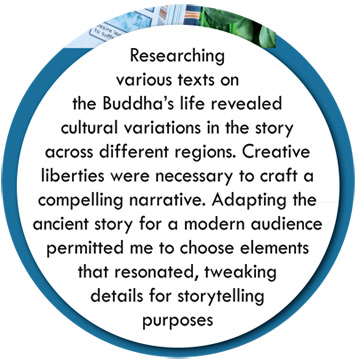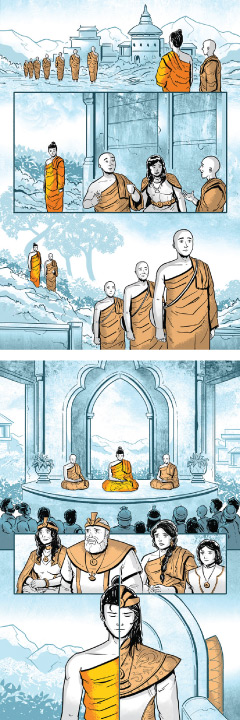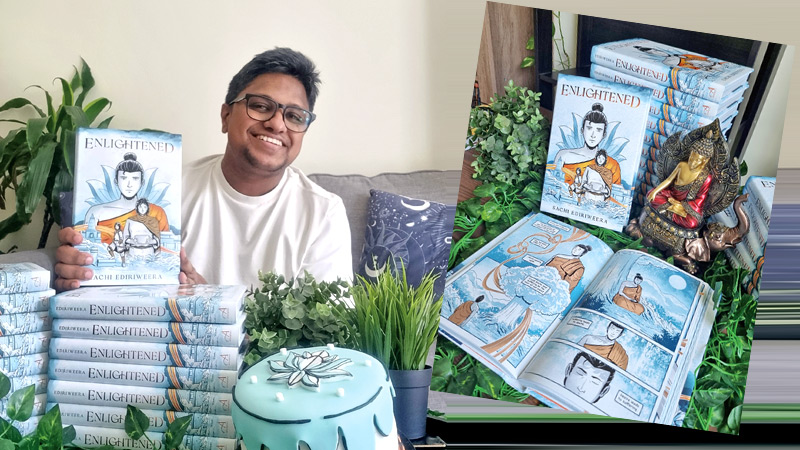In this illuminating dialogue, Sachi shares the inspirations and intricacies behind his unique retelling of Siddhartha’s life, the revered founder of Buddhism, with insights into the delicate dynamics between Siddhartha and King Suddhodana, a tension rooted in the prince’s desire to explore the world. Sachi’s exploration of the father-son relationship takes on a personal resonance, especially after embracing fatherhood himself during the book’s creation.
Q: Your latest graphic novel, “Enlightened,” is described as a unique retelling of the life of Siddhartha, the founder of Buddhism. What inspired you to choose this particular story?
 A: Graphic novels are immensely popular in the Western literary world, with critically acclaimed works like “Maus” winning the Pulitzer Prize. Nevertheless, graphic or comic novels are not as popular in our part of the world. In terms of how I got into it, I was doing digital illustration. I had a background in digital illustration and filmmaking.
A: Graphic novels are immensely popular in the Western literary world, with critically acclaimed works like “Maus” winning the Pulitzer Prize. Nevertheless, graphic or comic novels are not as popular in our part of the world. In terms of how I got into it, I was doing digital illustration. I had a background in digital illustration and filmmaking.
Combining storytelling from films with my drawing skills, I decided to venture into comics and graphic novels. “Enlightened” was born during the pandemic, providing a long-term project. The Buddha’s story fascinated me since childhood, and I wanted to create a version for young adults, focusing on emotional aspects often overlooked in historical retellings. The stories I knew were very much very factual or very historical. So, I sort of wanted to tell my own version of the story and the untouched emotional moments of the Buddha’s story.
Q: The scene where Siddhartha abandons his life as a prince and later meets his son is highlighted as a significant moment in the story. Can you discuss your decision to focus on this particular scene and how it ties into your own experiences and inspirations?
 A: Becoming a father myself during the creation of this book added a new perspective. The scene where Siddhartha leaves his family intrigued me for years. And later on when Prince Siddhartha and Princess Yashodhara, have a baby, he abandons his son. But he does so because he knows that they will be well taken care of in the palace.
A: Becoming a father myself during the creation of this book added a new perspective. The scene where Siddhartha leaves his family intrigued me for years. And later on when Prince Siddhartha and Princess Yashodhara, have a baby, he abandons his son. But he does so because he knows that they will be well taken care of in the palace.
After enlightenment, the Buddha returns to Kapilavastu. It creates a different dynamic, you have this completely changed person who is coming back to his hometown, and you got a son, who has never seen his father, and is very curious about where his father went, and why he went. After I became a parent, the dynamics of abandoning his family took on a new meaning. It created a unique family dynamic when Buddha returned as a changed person, providing an opportunity for emotional exploration. This scene, where Prince Rahula questions his father upon his return, has been with me for a long time and became a crucial part of “Enlightened.”
Q: How did you overcome the challenge of depicting the dynamic between Siddhartha and his father, King Suddhodana? How did you navigate and balance the tension between these characters to ensure it contributed to the narrative without becoming overwhelming?
A: The tension between Siddhartha and King Suddhodana revolves around the prince’s desire to explore the world.
The confrontation between those two characters, the character dynamic is like, King Suddhodana doesn’t want Prince Siddhartha to go out, because he fears that something bad might happen to him. I had that narrative dynamic since the beginning, where Prince Siddhartha asks, “Father, can I please go out?” And every time King Suddhodana he finds an excuse and says, “No, it’s safer here, you have everything inside this palace.”
The gradual progression of their conversations, where Siddhartha seeks permission to leave, builds up until readers realize the force behind keeping him inside. My editor pushed for a more in-depth exploration of this dynamic, elevating the stakes with each conversation. Balancing these characters required careful storytelling, ensuring the tension contributed to the narrative without overshadowing it.
Q: How did you approach the balance between historical accuracy and artistic license in adapting the story of the Buddha, considering the texts about him were written centuries after his passing?
A: Researching various texts on the Buddha’s life revealed cultural variations in the story across different regions. Creative liberties were necessary to craft a compelling narrative. Adapting the ancient story for a modern audience allowed me to choose elements that resonated, tweaking details for storytelling purposes. Recognizing the creative liberties present even in historical texts, I aimed to maintain the core narrative while creating an engaging and accessible graphic novel.
Q: Can you provide insights into the age group you aimed to be “Enlightened” and how you approached presenting the story in a way that is accessible and engaging even for young readers without losing the essence of the Buddha’s journey?
A: “Enlightened” was envisioned as a young adult book for ages 12 and above. While certain aspects might be complex for younger readers, the goal was to create a story that resonates across age groups. Exploring the emotional depth of Siddhartha’s journey, the graphic novel aims to engage readers with relatable themes, making the Buddha’s story accessible to a broad audience.
Q: Can you share some insights into the process of creating a graphic novel? How does collaboration play a role in bringing a graphic novel to life, and what unique challenges or aspects come with telling a story through this visual medium?
A: Graphic novels typically involve collaboration between a writer, artist, colorist, and letterer. The process can vary, with some artists preferring detailed scripts while others work from loose outlines. For “Enlightened,” I wore multiple hats, handling writing, drawing, coloring, and part of the lettering. Collaborating with an editor from Simon & Schuster, Aliza Liu, added valuable insights. Challenges include balancing visual and narrative elements, ensuring the story flows seamlessly in a visual format.
Q: “Enlightened” took around two and a half years to make. Can you share some of the challenges and rewarding moments you experienced during the creation process?
A: Meeting deadlines and adapting the Buddha’s story for a global audience posed significant challenges. The rewarding moments came as positive reviews and reader feedback started pouring in after the book’s release. Overcoming challenges and witnessing the book’s reception made the two and a half years of effort worthwhile.
Q: Your graphic novels often draw inspiration from Sri Lankan culture. How does your cultural background influence your storytelling and artistic style, and how do you strike a balance between creating stories that are culturally rooted while also appealing to a global audience?
A: Growing up with global influences such as Disney movies, I aim to create narratives rooted in Sri Lankan culture while maintaining universal storytelling elements. The challenge lies in making characters and themes relatable to a broader audience. By adding emotional depth to characters and exploring universal themes, I strike a balance that allows stories inspired by my cultural background to resonate globally.
Q: As a writer, what have you learned from the beginning of your career to now? Are there specific changes or growth in your approach to storytelling that you find particularly important?
A: The key lesson is to engage in projects that genuinely interest you. Creating graphic novels requires significant time, and the motivation to see the story come to life is crucial. Balancing the challenge of adapting historical stories while making them globally appealing has been a significant part of my growth. The focus remains on telling compelling stories with emotional depth.
Q: As a creator who wears multiple hats, balancing a day job as a design lead, being a comics writer and artist, and a father, how do you manage your time effectively, and do you find that these different roles influence each other creatively?
A: Juggling various roles demands setting personal deadlines and ensuring progress, even if minimal, every day. The concept of “Non-zero workdays,” where any small task contributes to progress, keeps the creative energy flowing. While challenging, the drive to bring stories to life, especially with “Enlightened,” kept me going. Each role, as a designer, writer, artist, and father, influences the other, contributing to a holistic creative perspective.
Q: Can you share a bit about what’s next for you in terms of your writing projects?
A: While exploring new story ideas, I’m in no rush to embark on another project immediately. Currently, I’m focused on promoting “Enlightened” and ensuring its availability in Sri Lanka. Reviews have been positive, and conversations are ongoing with local bookstores. Exploring new themes and projects is in the pipeline, ensuring that the next endeavor is as engaging and compelling as the journey of Siddhartha in “Enlightened.”







